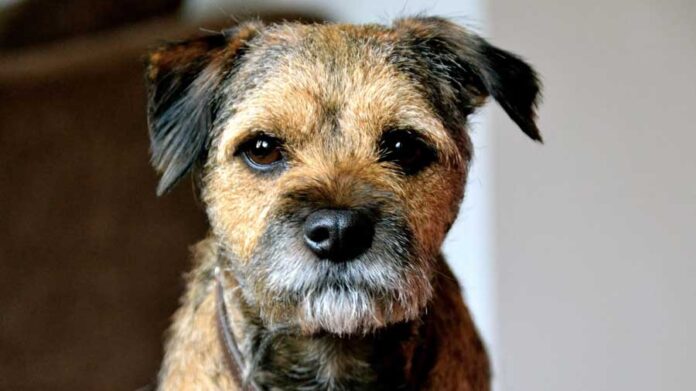Last Updated on August 23, 2023 by Fumipets
Unveiling the Charm of the Border Terrier
The Border Terrier, known for its boundless energy and distinctive appearance, is a remarkable breed cherished for its intelligence and courage. With its iconic otter-like head, this small to medium-sized dog displays affectionate and adaptable qualities, making it an excellent companion and watchdog.
Its wiry double coat, found in various colors, adds to its charm. Border Terriers thrive in diverse living environments, including apartments, as long as they receive ample exercise and mental stimulation. Regular grooming, daily walks, and playtime are essential to keeping these spirited dogs physically and mentally fulfilled, fostering a strong bond between them and their owners.
Little dogs with a lot of personality, border terriers are kind and affectionate. This breed is very bright, excels at agility and games, and loves spending time with the family. Border terriers are excellent with children, but they are also a good option for anybody with the time and energy to devote to them. They need some activity, but as long as they are kept on a leash, they make excellent outdoor companions. Because of their terrier heritage and strong hunting drive, they could pursue smaller creatures.
The border terrier is a sturdy breed that normally requires little maintenance, and its wiry hair only has to be brushed once every two weeks or so to be in excellent condition.
Appearance
The border terrier is a petite, wiry-haired puppy with a distinctive appearance that weighs about 15 pounds. He does, in fact, have what the breed standard refers to as a “otter head,” which is not totally incorrect. With the exception of the fishy odor, they have the lovely appearance of the tiny young swimmers thanks to their unusually perplexed eyebrows and whiskered lips.
The double coat of border terriers has rougher, wirier hairs on the exterior and softer, fluffier hairs within. Overall, they need little care, and maintaining their neat appearance is simple. They don’t shed a much either.
The colors of border terriers include red, wheaten (or cream), blue and tan, and grizzle (a combination of dark and light fur). They are skilled at giving “puppy dog eyes” to get additional goodies and pet scritches. They have dark hazel eyes.
Temperament
Border terriers are one of Shlomo Frieman, DVM’s favorite breeds, and the founder of the Animal Hospital of Factoria in Bellevue, Washington. They exhibit many of the typical terrier characteristics, such as high intellect, strong activity, and a propensity to cause mischief, according to Frieman, “but they’re more laid-back [than some other terriers.]”
since of their balanced temperament, border terriers get along well with kids and thrive in a dynamic family environment since they like playing games and being active. However, they’re also great for seniors who are still active and for those who are single.
Border terriers behave more like large dogs than little dogs. According to Star Ott, president of The Border Terrier Club of America, who has bred and shown these dogs for more than 20 years, you can take them out and do things, and they’re prepared to go 99 percent of the time. They are excellent companions for busy families as well as senior people who are still active.
Ott claims that this breed doesn’t need much activity beyond a daily long walk and indoor activities, but if you want to do more with them, that’s fantastic.
“Physical exercise is important, but it’s also important to stimulate their mind, otherwise they can become naughty,” explains Ott. You may accomplish this by playing games with them, teaching them tricks, or engaging in any other activity involving the dog.
Border terriers are said to be exceptionally trainable and clever dogs. As a result, they are among the greatest agility dogs and are eager to learn. Ott notes that although sending your children to school is ideal, you may also look at YouTube videos or online courses.
Border terriers are often pleasant tiny puppies that get along with other dogs, even though they’ll let you know if somebody is at the door. Based on their socialization, they may even get along well with cats. According to Frieman, owners should exercise caution while keeping border terriers in a home with cats and other small animals because of their terrier-like drive. According to Frieman, “a lot of it depends on your particular border terrier’s personality.”
Border terriers are wonderful small dogs that would fit the majority of owners, even those who have never had a dog before. Border terriers may make excellent first-time dogs if the owner is prepared to put in some effort and enroll the dog in puppy training lessons, according to Ott.
Living Needs
As long as you satisfy their activity needs, border terriers don’t need much room and are content living in flats. It could be enough to take a decent stroll for 30 minutes each day. However, you can bet that your border terrier will enjoy running alongside you if you enjoy taking long hikes or runs through the park. But border terriers are not the best off-leash companions due to their strong prey drive. “The trouble with that is they don’t pay attention to anything around them while they’re on the hunt,” Ott explains. “They were initially designed to go after foxes and kill rats.
Although they are small, they can be high jumpers and stubborn diggers, so if you intend to leave your dog in the yard unattended, you should take those risks into consideration. In order to prevent them from escaping and chasing after a squirrel or a rabbit, it is important to construct your fence high and with enough depth.
Border terriers want to spend as much time as possible with their owners and do not perform well when left alone for extended periods of time. Even while they like being active, they also enjoy relaxing on someone’s lap (particularly as they age and lessen some of their puppy rambunctiousness).
Care
Grooming a border terrier is not that difficult. Most of the time, all they need to maintain their coat is a weekly brushing and an occasional bath. However, during their seasonal shedding, you’ll need to brush them every day (and you may want to use a special brush that can reduce shedding). Border terriers don’t shed a lot during the off-season.
Border terriers are sociable and like being with their family, whether they are on a road trip, going for a long walk, or just lounging around the house. They like playing with other dogs and enjoy a good romp.
According to Ott, among the terrier breeds, border terriers are one of the easiest to teach. Finding out what drives your dog makes training easier and can be done with positive reinforcement.
“They are the kind of dog that asks, ‘What’s in it for me?'” They will quickly pick up skills like sitting and staying, but they want to know where the cookie is at the end, she claims. However, owners will still need to put in the effort to get them to do what you want them to even with all the treats in the world. You can’t simply keep this dog in your backyard and hope it turns up to be a decent dog, says Ott. Border terriers are very intelligent, and if you don’t keep them occupied, they will outperform you.

Health
Border terriers are strong dogs, according to Frieman, despite the possibility of certain hereditary disorders that result in seizures, cataracts, and orthopedic problems including hip dysplasia. You should always inquire about the breeder’s methods for checking for these problems, advises Frieman.
Border terriers often have long, active lives and retain their energy as they mature. “As they age, they tend to be less active, but that doesn’t mean you can’t still take them on long walks,” Ott says, noting that she knows individuals who regularly go on 1- or 2-mile treks with a 15-year-old border terrier.
History
The Border Terrier Club dates the breed’s beginnings to the middle of the 1800s in the arid terrain along the Scottish–English border. The dog was developed by farmers to chase foxes that murdered their cattle, making it one of the first terrier breeds.
The border terrier was once known by a number of names, including Coquetdale and Redesdale, which were the names of the regions where they originated. The term “border terrier” stuck by the late 1800s as a result of the breed’s connection to the Border Hunt in Northumberland, a long-running fox hunt.
The American Kennel Club later recognized the breed ten years after The Kennel Club of the United Kingdom did in 1920.
Frequently Asked Questions
What is the Border Terrier known for?
The Border Terrier is renowned for its energetic nature, intelligence, and distinctive otter-like head.
What are the typical characteristics of a Border Terrier?
Border Terriers are affectionate, adaptable, and courageous dogs that make excellent companions and watchdogs.
How would you describe the Border Terrier’s appearance?
Border Terriers have a wiry double coat that comes in various colors, and they are of small to medium size, with a well-proportioned build.
What kind of living environment suits a Border Terrier?
Border Terriers can thrive in various settings, including apartments, as long as they receive regular exercise and mental stimulation.
What is the grooming and care routine for Border Terriers?
Border Terriers require regular grooming to maintain their coat and prevent matting. They also benefit from daily walks and playtime to keep them physically and mentally active.
https://www.youtube.com/watch?v=x81Hq3_BE7Q


















